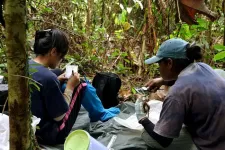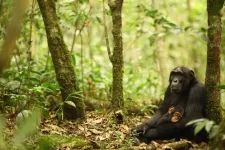(Press-News.org) CHAMPAIGN, Ill. — While physical neglect is understudied compared to physical, sexual or emotional abuse, neglect is just as damaging to children’s social development, a new study indicates.
More than 9,150 individuals, nearly 41% of whom retrospectively reported some form of maltreatment before age 12 or reaching the sixth grade, were included in the study, published in the journal Child Abuse and Neglect. The project explored the impact of abuse or neglect on three dimensions of children’s structural peer relationships — whether maltreated youth were less social/more withdrawn, less popular with or avoided by their peers and how tightly knit or cohesive their social connections were.
Experiencing any form of maltreatment negatively affected differing dimensions of children’s social development — but only physical neglect disrupted all three of them, according to sociology professors Christina Kamis, of the University of Illinois Urbana-Champaign, and co-author Molly Copeland, of the University of Notre Dame.
“Childhood adversity and maltreatment may disrupt the process of developing these peer relationships in early life, and we've shown in our prior work these skills are important for mental health and well-being over one’s lifetime,” Kamis said. “This is such a critical part of the life course, where children’s focus is shifting from parents to peers, and they are learning how to connect with other people. It prepares young people for romantic relationships and social relationships moving forward, so it has vast consequences.”
The sample population for the study was derived from the National Longitudinal Study of Adolescent to Adult Health, also called Add Health, which initially surveyed more than 90,000 students in grades 7-12 across the U.S. in the 1990s and followed over 20,000 of the students in the main study into adulthood.
Nearly 10.3% of those included in the current study’s sample population retrospectively reported experiencing physical neglect, while 28.6% reported physical abuse, about 17.4% reported emotional abuse and more than 4.3% reported sexual abuse, proportions the researchers said were consistent with prior research using Add Health data. The majority of those in the current project who experienced abuse or neglect reported only one form of it.
Using in-school surveys, participants were asked to name up to five of their closest male and female friends at their school. Accordingly, participants’ sociality was measured by the number of peers they named as friends, while their popularity reflected the number of peers who listed them as a friend. The current study also assessed a novel perspective not often addressed by prior studies: youths’ social network cohesion, which reflected how tight knit or fragmented — i.e., scattered across various groups and lacking interconnections — their friend groups were.
Each child listed about four students as friends on average, and each of these children was listed as a friend by about four peers. However, those who experienced some form of abuse or neglect named fewer peers as friends, suggesting they were less social or were withdrawn, the researchers found.
“Maltreated children often feel shame and may have lower self-esteem and sense of belonging as a consequence of maltreatment, which precipitates withdrawal from their peers,” Kamis said. “Experiencing abuse or neglect may also cause children to anticipate rejection or victimization by their peers, making them less likely to reach out to others.”
In addition, those in the study who experienced abuse or neglect were less likely to be named as friends by others at their school, suggesting that they were less popular or avoided by other students.
“Maltreatment itself is stigmatized, and if it leaves a visible trace or is known to peers, it may cause peers to avoid these children,” Kamis said. “Maltreatment may also increase behaviors that reduce these children’s desirability as a friend, such as greater difficulty regulating their emotions, increased aggression or lower prosocial behavior.”
The researchers also found that maltreated adolescents were less likely to belong to tight-knit groups and more likely to have fragmented relationships that spanned multiple groups.
Cohesive, interconnected friend groups may sanction non-normative behaviors such as aggression or emotional dysregulation exhibited by maltreated peers, or reject these students, relegating them to fragmented friendships across the social environment, Kamis said.
Conversely, maltreatment may lead children to develop greater mistrust of other people or insecure attachment styles that make belonging to an interconnected group stressful, causing them to withdraw from close friend groups, she said.
Examining social effects by type of maltreatment, Kamis and Copeland found that experiencing sexual abuse predicted withdrawal, while emotional and physical abuse predicted avoidance by peers and fragmentation. Only physical neglect predicted negative effects on all three dimensions.
While Kamis said they were somewhat surprised by the ubiquitous effects of physical neglect, the finding makes sense because the manifestations of neglect affect how maltreated children see themselves as well as their peers’ perceptions of them.
“If you are not receiving proper housing, food and clothing, or you're not being bathed or taken care of at home, that can be visible to your peers and have stigma attached to it,” Kamis said. “The external manifestations of neglect may cause other children to avoid being friends with that child, while the shame the neglected child feels can also cause them to withdraw from others.”
Since children and adults who experience abuse or neglect are at greater risks of mental health problems and other threats to their well-being, Kamis advocates screening across the lifespan and providing support. “School can be a difficult arena for these children, so recognizing that they might need additional support developing friendships and breaking down some of the barriers with their peers is critical,” she said. “Missing the developmental benefits of peer networks may have a lasting impact on their ability to form social connections and experience greater well-being across their lifetimes.”
END
Physical neglect as damaging to children’s social development as abuse
2025-01-09
ELSE PRESS RELEASES FROM THIS DATE:
Earth scientist awarded National Medal of Science, highest honor US bestows on scientists
2025-01-09
UNIVERSITY PARK, Pa. — Richard Alley, Evan Pugh University Professor of Geosciences at Penn State, was awarded the National Medal of Science at a White House ceremony on Jan. 3.
Alley was one of 23 individuals and two organizations awarded the 2025 National Medals of Science and National Medals of Technology and Innovation, the nation’s highest honors for achievement and leadership in science and technology.
“Dr. Alley is deeply deserving of this most prestigious honor, and it is heartening to know that our nation sees in him what the Penn State community has known for decades,” said Penn State President Neeli Bendapudi. “Dr. ...
Research Spotlight: Lipid nanoparticle therapy developed to stop tumor growth and restore tumor suppression
2025-01-09
Yang Zhang, PhD, and Jinjun Shi, PhD, both of the Center for Nanomedicine and Department of Anesthesiology, Perioperative and Pain Medicine at Brigham and Women’s Hospital, are co-senior authors of a paper published in ACS Nanoscience Au, “Lipid Nanoparticle Delivery of mRNA and siRNA for Concurrent Restoration of Tumor Suppressor and Inhibition of Tumorigenic Driver in Prostate Cancer.”
How would you summarize your study for a lay audience?
Most cancers occur when there is an imbalance of cellular growth and inhibition, causing cells to grow rapidly and form tumors in the body. For example, ...
Don’t write off logged tropical forests – converting to oil palm plantations has even wider effects on ecosystems
2025-01-09
A research team led by the University of Oxford has carried out the most comprehensive assessment to date of how logging and conversion to oil palm plantations affect tropical forest ecosystems. The results demonstrate that logging and conversion have significantly different and cumulative environmental impacts. The results have been published today (10 January) in Science.
Understanding how different aspects of tropical forests are affected by logging and conversion to oil palm plantations is important for identifying priority habitats for conservation and restoration. It can also help aid decisions on land use – for instance, whether a logged forest should be ...
Chimpanzees are genetically adapted to local habitats and infections such as malaria
2025-01-09
Chimpanzees bear genetic adaptations that help them thrive in their different forest and savannah habitats, some of which may protect against malaria, according to a study by an international team led by UCL researchers.
Chimpanzees are our closest living relatives, sharing over 98% of their DNA with humans, and the scientists say that their findings, published in Science, can not only teach us about our own evolutionary history, but also about the biology of malaria infection in humans.
Chimpanzees are endangered ...
Changes to building materials could store carbon dioxide for decades
2025-01-09
Replacing conventional building materials with materials modified to store carbon dioxide could move the planet closer to net-zero greenhouse gas emissions, according to a new study by Elisabeth Van Roijen and colleagues. The researchers calculate that full replacement of conventional building materials with these CO2-sequestering alternatives could store as much as 16.6 ± 2.8 gigatons of CO2 each year – an equivalent to about 50% of the anthropogenic CO2 emissions in 2021. Removing carbon dioxide from the atmosphere, along with decreasing emissions, is important for slowing ...
EPA finalized rule on greenhouse gas emissions by power plants could reduce emissions with limited costs
2025-01-09
In this Policy Forum, John Bistline and colleagues analyze the potential impacts of the U.S. Environmental Protection Agency’s finalized power plant rules regarding greenhouse gas emissions. Using nine models of the U.S. electric sector and energy systems, the researchers found that the rules would speed up the reduction of emissions in the power sector. Under the rules, the levels of carbon dioxide emitted by the sector would be 61%-81% below 2005 levels by 2040. Under current policies, emission levels would be 51% to 83% below 2005 levels by 2040, ...
Kangaroos kept a broad diet through late Pleistocene climate changes
2025-01-09
Samuel Arman and colleagues’ close examination of tooth microwear among living and extinct kangaroo species suggests that most of the species living in Australia during the Late Pleistocene had a broad, generalist diet rather than being specialized grazers. This broad diet likely allowed them to survive the glacial-interglacial cycles that drove fluctuations in vegetation on the continent. The findings add more evidence to the idea that human hunting, rather than failure to adapt to climate changes, ...
Sex-specific neural circuits underlie shifting social preferences for male or female interaction among mice
2025-01-09
Male and female mice both prefer social interaction with female mice under normal conditions, but both switch to preferring males when their survival is threatened, according to a new study by Anqi Wei and colleagues. These preferences are mediated by different neuronal circuitry in male and female mice related to dopaminergic neurons in the brain’s ventral tegmental area, the researchers found. The findings offer a clearer picture of the underlying biology of socio-sexual preferences. These preferences are essential for successful reproduction, ...
The basis of voluntary movements: A groundbreaking study in ‘Science’ reveals the brain mechanisms controlling natural actions
2025-01-09
Eight years of work. A collaboration between the Laboratory of Neuroethology of Non-Human Primates of the Department of Medicine and Surgery of the University of Parma, led by Luca Bonini, and a team from the Biorobotics Institute of the Sant'Anna School of Pisa, coordinated by Alberto Mazzoni, principal investigator at the Computational Neuroengineering Lab, with the contribution of Silvestro Micera, professor in Bioingeneering. Support from three projects funded by the European Research Council (ERC) and as many Italian national projects, including MNESYS and BRIEF. These are just some of the elements of a groundbreaking study published in ...
Storing carbon in buildings could help address climate change
2025-01-09
Construction materials such as concrete and plastic have the potential to lock away billions of tons of carbon dioxide, according to a new study by civil engineers and earth systems scientists at the University of California, Davis and Stanford University. The study, published Jan. 10 in Science, shows that combined with steps to decarbonize the economy, storing CO2 in buildings could help the world achieve goals for reducing greenhouse gas emissions.
“The potential is pretty large,” said Elisabeth Van ...





